War Stories 4
Enjoy the stories in this section. Some of them may even have been true!! Have a favorite war story you've been relating over the years? Well sit down
and shoot us a draft of it. Don't worry, we'll do our best to correct grammar, punctuation, and spelling before we publish it. to us and we'll publish them for all to enjoy.

First Two UH-1H Aircraft Assigned to 15th Med Bn
By MAJ Larry G. Hatch (USA Ret)
WO Call Sign: Mercy 11
WO Arthur Martin and I were flown to Vung Tau to take delivery of
the first two new UH-1H helicopters, an improvement over the D model’s L-11
engine versus the much more powerful L-13 engine. We both had a crew chief
along to assist and fill the other front pilot’s seat.
While flying the two aircraft in trail formation up the coastline
towards home base, the helicopter I was flying lost all its hydraulic fluid,
and the hydraulic warning light came on. Beings you can’t hover the aircraft
with the hydraulics out, they teach running landings in flight school to
deal with these situations. So, when I was adjacent to Cam Rahn Bay Air
Base, I radioed the Army Airfield next to the base for permission to make an
emergency running landing. I made a shallow, 12-degree approach, keeping my
airspeed up until touching the aircraft’s skids down on the very first part
of the PSP runway. I had to get the crew chief to help put downward pressure
on the collective stick to help take pitch out of the rotor blades and slow
us down. As it was, the helicopter slid down three-fourths of the runway
before stopping. I made a picture-perfect, flight school, textbook landing.
The Major in charge of the airfield came running out and chewed me up one
side and down the other for landing at “his” airfield. Well, excuse me. Mr.
Martin let him have both barrels.
We left the broken helicopter there and flew home in the other one.
Mr. Martin flew back the next day with maintenance personnel and fixed the
helicopter. When the helicopter was being built, a mechanic crimped one of
the hydraulic line fittings so badly that it leaked at the fitting. The leak
wasn’t found after the helicopter was first test-flown back in the United
States. My 45-minute flight was all it took to pump out all the hydraulic
fluid.
Unbeknownst to me, Mr. Martin had saved the crimped hydraulic
fitting and had it made into a plaque I was given when departing Vietnam in
December 1967. That plaque is hanging on the wall in my den.
[ Return To Index ]

Coast Mission
By MAJ Larry G. Hatch (USA Ret)
WO Call Sign: Mercy 11
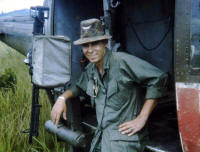
WO1 Hatch
Right after the mission on 8 April 1967, where both CPT Eldon Ideus
and I were wounded, I was sent up North along the coastline in support of
some Marine Corps operations to give me a break from the action. Well, I
flew out of the frying pan into the fire. I was in deep doo-doo on my very
first mission. The pickup was right on the coastline of the South China Sea.
The only vegetation between the rice patties and the Sea was these patches
of 20-feet high willows, among other smaller trees. The unit on the ground
popped a smoke grenade; I identified the color of the smoke and was
approaching the LZ when 15 feet off the ground, all hell broke loose. I
wasn’t flying at the controls because I was breaking in a new pilot, so I
was looking out my pilot’s left door window looking at the mudflats and
water on the ground when I found myself staring down a rifle barrel. A Viet
Cong (VC) dressed in all black (typical dress), barefooted, squatted down on
the mud bank, was pointing his rifle at me. He fired and the round went
between my feet, hit the cyclic stick, severed wiring, which resulted in my
side of the cockpit filling up with smoke. At the same time, we were taking
automatic weapons fire, and I was telling my co-pilot on my radio headset to
“Get the hell out of here.” Well, you are in your most vulnerable position
when you are slowing the aircraft’s descent for landing and you pull up the
collective to get airborne. The helicopter’s rotor blade speed immediately
starts to bleed off. I guess it was my instructor pilot’s instinct, but I
had taken over the controls, held the RPM bleed off to 6000 RPM (down from
6600 RPM) and was able to start moving forward as the rotor blades were
chopping up those willows like a lawnmower. At least we weren’t crash
landing. It seemed like we flew through those willows forever until we flew
out of them, turned right towards the rice paddies with the helicopter’s
skids about 5 feet off the ground as I was trying to gain airspeed and
slowly lowering the collect to increase RPM. As you can probably determine
that combination of forward cyclic stick to gain airspeed and downward
collective to gain rotor RPM without hitting the ground was tricky. To top
things off, I was trying to see through a cloud of smoke from burning wire,
RPM warning indicator bleeping constantly and whatever else was going on to
keep the aircraft flying. Can you imagine a Vietnamese rice farmer standing
up, pushing his dugout canoe along the rice paddy using a long pole, and I’m
flying straight at him, true story? I’ll bet he filled his pants before he
bailed out into the paddy. I didn’t hit the pole or the farmer, but I didn’t
alter my flight path; I figured I was the one with the emergency and
besides, I had the right-of-way (come to think of it, maybe not). I still
laugh thinking about it (the farmer, not the mission).
After two harrowing missions within three days of each other, they
sent me on R&R to Hawaii on 19 August 1967. I wanted to go to Australia and
see those beautiful ladies they kept showcasing in the “Stars & Stripes”
newspaper but, Hawaii was better than nothing.
[ Return To Index ]

An Lo Valley Ambush
By MAJ Larry G. Hatch (USA Ret)
WO Call Sign: Mercy 11
CPT Eldon Ideus and I (WO Larry Hatch) were making a medevac
pick-up in the An Lo Valley outside of LZ English. While I was flying
downwind, I couldn't help but think how beautiful the elephant grass looked;
it was like a golf course fairway lined on both sides by palm trees. I made
my final approach to an infantry soldier standing waist-high in the grass,
holding a smoke flare. I was flaring the helicopter for landing, when at 15
ft. all hell broke loose. The VC had set up an ambush, and we were taking
automatic weapons fire from the palm trees as well as the ground.
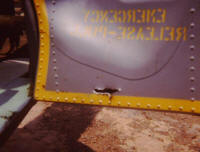
Round Hit Ideus' Foot
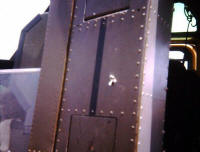
Round Through Seat
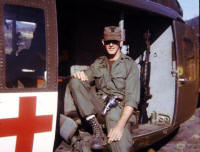
CPT Ideus
I immediately broke off the approach, pulling pitch enough to
maintain RPM at 6,000 (which had bled off from 6,600 RPM) while
simultaneously applying forward cyclic to gain airspeed. With the RPM
low warning light blaring and flashing and trying to stay at 15 ft.
without hitting the ground, I finally built up enough airspeed and RPM
to get away from the gunfire. A bullet had gone through the left door
and CPT Ideus' right foot. Another round went through the open cargo
area, hit the metal plate on the back top of my armored seat, which
holds the seal belt web in place, bent it up, sending shrapnel into my
neck and then ricocheting off to hit the aircraft's side panel behind
the door. I radioed ahead to LZ English telling them we didn't make the
pick-up, but we had wounded onboard and a wounded helicopter.
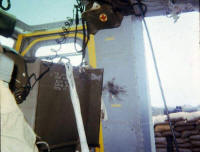
Seat Hit with Ricochet
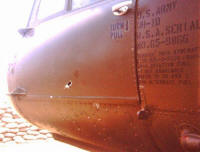
One of 127 Hits

WO1 Hatch
Our wounds were attended to, and CPT Ideus was medevaced back to
the United States. I sure was going to miss old "Magnet Ass Ideus," as I
called him, for every time we flew together, we got the hell shot out of the
aircraft. Our Maintenance Officer, WO Arthur Martin, and Technical Inspector
SP6 Clyde Moore counted 127 bullet holes through the aircraft (exit holes
were not counted). We were lucky that day. MAJ Goodman told me that I needed
to relax and get away from the action, so I was sent up North along the
coastline in support of the Marines. The very first mission proved to be no
better than the last bullet-riddled mission in the An Lo Valley. But that's
another war story to read about on our Web site.
[ Return To Index ]